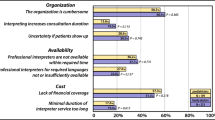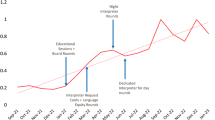Abstract
OBJECTIVE: To determine whether professional interpreter services increase the delivery of health care to limited-English-proficient patients.
DESIGN: Two-year retrospective cohort study during which professional interpreter services for Portuguese and Spanish-speaking patients were instituted between years one and two. Preventive and clinical service information was extracted from computerized medical records.
SETTING: A large HMO in New England.
PARTICIPANTS: A total of 4,380 adults continuously enrolled in a staff model health maintenance organization for the two years of the study, who either used the comprehensive interpreter services (interpreter service group [ISG]; N=327) or were randomly selected into a 10% comparison group of all other eligible adults (comparison group [CG]; N=4,053).
MEASUREMENTS AND MAIN RESULTS: The measures were change in receipt of clinical services and preventive service use. Clinical service use and receipt of preventive services increased in both groups from year one to year two. Clinical service use increased significantly in the ISG compared to the CG for office visits (1.80 vs 0.70; P<.01), prescriptions written (1.76 vs 0.53; P<.01), and prescriptions filled (2.33 vs 0.86; P<.01). Rectal examinations increased significantly more in the ISG compared to the CG (0.26 vs 0.02; P=.05) and disparities in rates of fecal occult blood testing, rectal exams, and flu immunization between Portuguese and Spanish-speaking patients and a comparison group were significantly reduced after the implementation of professional interpreter services.
CONCLUSION: Professional interpreter services can increase delivery of health care to limited-English-speaking patients.
Similar content being viewed by others
References
Tumulty P. What is a clinician and what does he do? N Engl J Med. 1970;283:20–4.
Statistical Abstract of the US 1990 Census. Washington, DC:US Bureau of the Census; 1993.
Woloshin S, Bickell N, Schwartz L, Gany F, Welch G. Language barriers in medicine in the United States. JAMA. 1995;273:724–8.
Association of State and Territorial Offices. ASTHO Bilingual Health Initiative: Report and Recommendations. Washington, DC: Office of Minority Health; 1992.
Need for interpreter/translation services critical in hospitals and other clinical settings. Health Care Strategic Manage. 1995;13:15.
Woloshin S, Schwartz L, Katz S, Welch H. Is language a barrier to the use of preventive services? J Gen Intern Med. 1997;12:472–7.
Hu DJ, Covell RM. Health care usage by Hispanic outpatients as a function of primary language. West J Med. 1996;144:490–3.
Solis J, Marks G, Garcia M, Shelton D. Acculturation, access to care, and use of preventive service by Hispanics: findings from HHANES 1982–84. Am J Pub Health. 1990;80:11–9.
Pitkin Derose K, Baker DW. Limited English proficiency and Latinos’ use of physician services. Med Care Res Rev. 2000;57:76–91.
Sarver J, Baker DW. Effect of language barriers on follow-up appointments after an emergency department visit. J Gen Intern Med. 2000;15:256–64.
Morales LS, Cunningham WE, Brown JA, Honghu L, Hays RD. Are Latinos less satisfied with communication by health care providers? J Gen Intern Med. 1999;14:407–9.
Carrasquillo O, Orav EJ, Brennan TA, Burstin HR. Impact of language barriers on patient satisfaction in an emergency department. J Gen Intern Med. 1999;14:82–7.
Baker D, Hayes R, Puebla Fortier J. Interpreter use and satisfaction with interpersonal aspects of care for Spanish-speaking patients. Med Care. 1998;36:1461–70.
Ginsberg C, Martin D, Andrulis D, Shaw-Taylor Y, McGregor C. Interpretation and Translation Services in Health Care: A Survey of US Public and Private Teaching Hospitals. Washington, DC: National Public Health and Hospital Institute; 1995:1–49.
Schmidt RE, Ahart A, Shur G. Limited English Proficiency as a Barrier to Health & Social Services. Washington, DC: Macro International, Inc.; 1995.
Putsch R. Cross-cultural communication. JAMA. 1985;254:3344–8.
Haffner L. Cross-cultural medicine: a decade later. West J Med. 1992;157:255–9.
Marcos LR. Effects of interpreters on the evaluation of psychopathology in non-English-speaking patients. Am J Psychiatry. 1979;136:171–4.
Ebden P, Bhatt A, Carey OJ, Harrison B. The bilingual consultation. Lancet. 1988;88:88.
Vasquez C, Javier R. The problem with interpreters: communicating with Spanish-Speaking patients. Hosp Community Psychiatry. 1991;42:163–5.
Manson A. Language concordance as a determinant of patient compliance and emergency room use in patients with asthma. Med Care. 1988;26:1119–28.
Baker D, Parker R, Williams M, Coates WPK. Use and effectiveness of interpreters in an emergency department. JAMA. 1996;275:783–8.
Choo P, Rand CS, Inui TS, et al. Validation of patient reports, automated pharmacy records, and pill counts with electronic monitoring of adherence to antihypertensive therapy. Med Care. 1999;37:846–57.
Safran DG, Taira DA, Rogers WH, Kosinski M, Ware JE, Tarlov AR. Linking primary care performance to outcomes of care. J Fam Pract. 1998;47:213–20.
Thom DH, Campbell B. Patient-physician trust: an exploratory study. J Fam Pract. 1997;44:169–76.
Kao AC, Green DC, Zaslavsky AM, Koplan JP, Cleary PD. The relationship between method of physician payment and patient trust. JAMA. 1998;280:1708–14.
Author information
Authors and Affiliations
Corresponding author
Additional information
EAJ was supported by a Robert Wood Johnson Clinical Scholars Fellowship at the University of Chicago at the time she completed this work.
Rights and permissions
About this article
Cite this article
Jacobs, E.A., Lauderdale, D.S., Meltzer, D. et al. Impact of interpreter services on delivery of health care to limited-English-proficient patients. J GEN INTERN MED 16, 468–474 (2001). https://doi.org/10.1046/j.1525-1497.2001.016007468.x
Issue Date:
DOI: https://doi.org/10.1046/j.1525-1497.2001.016007468.x




